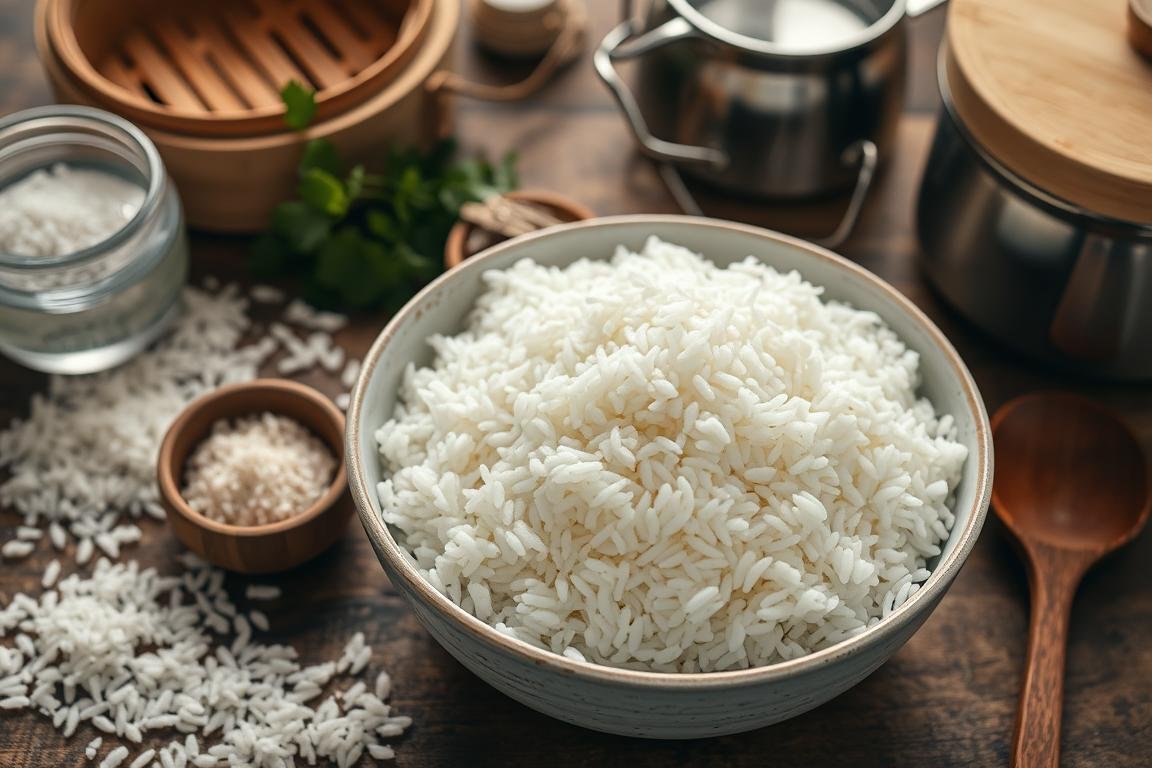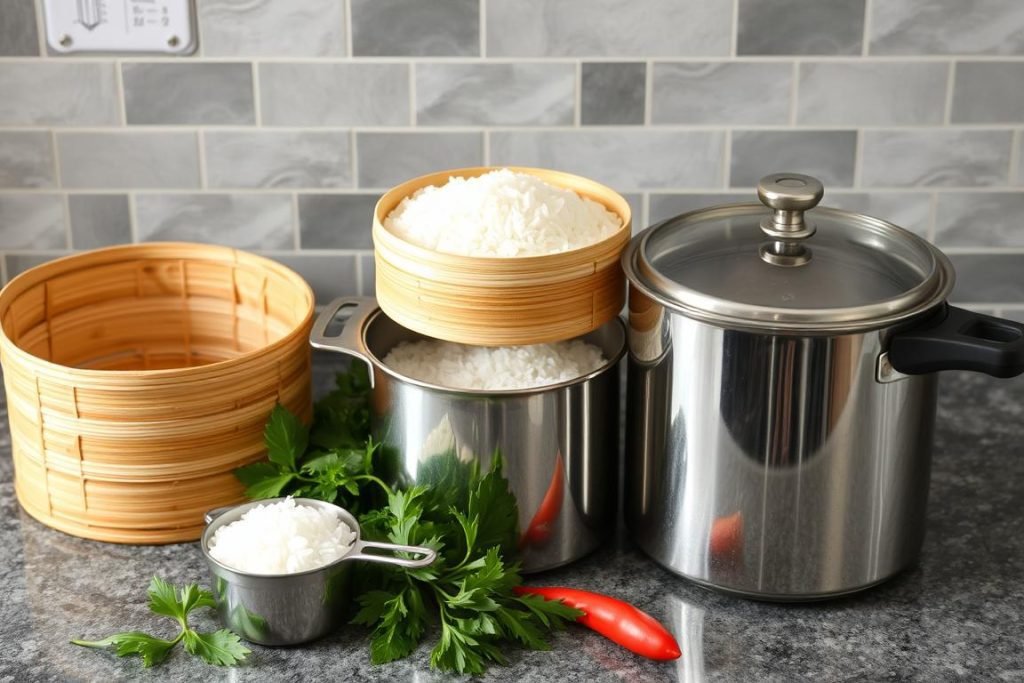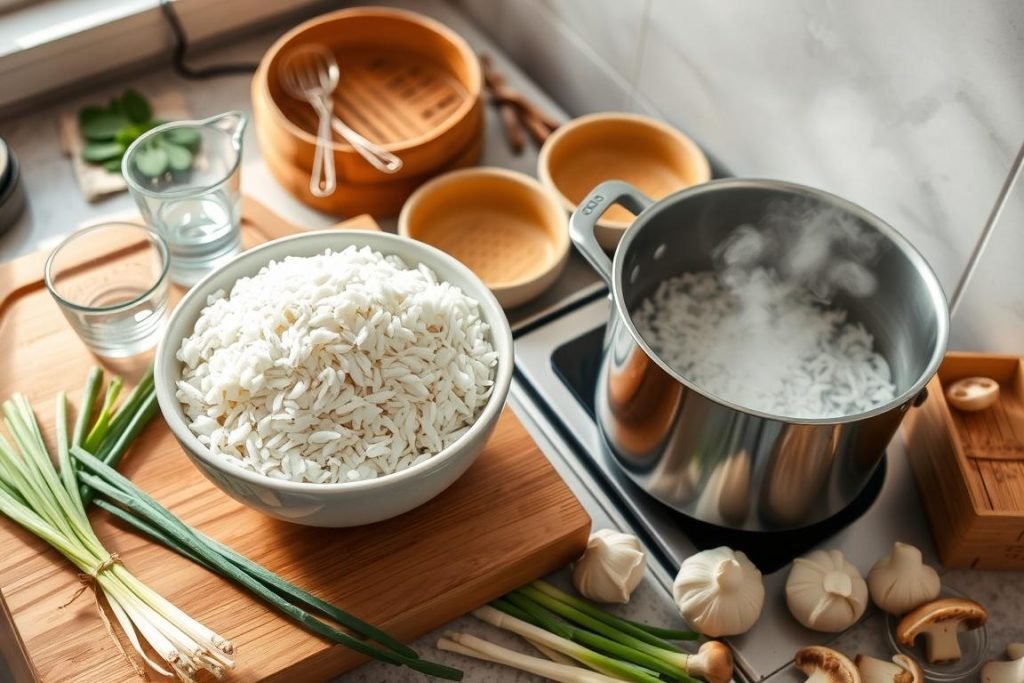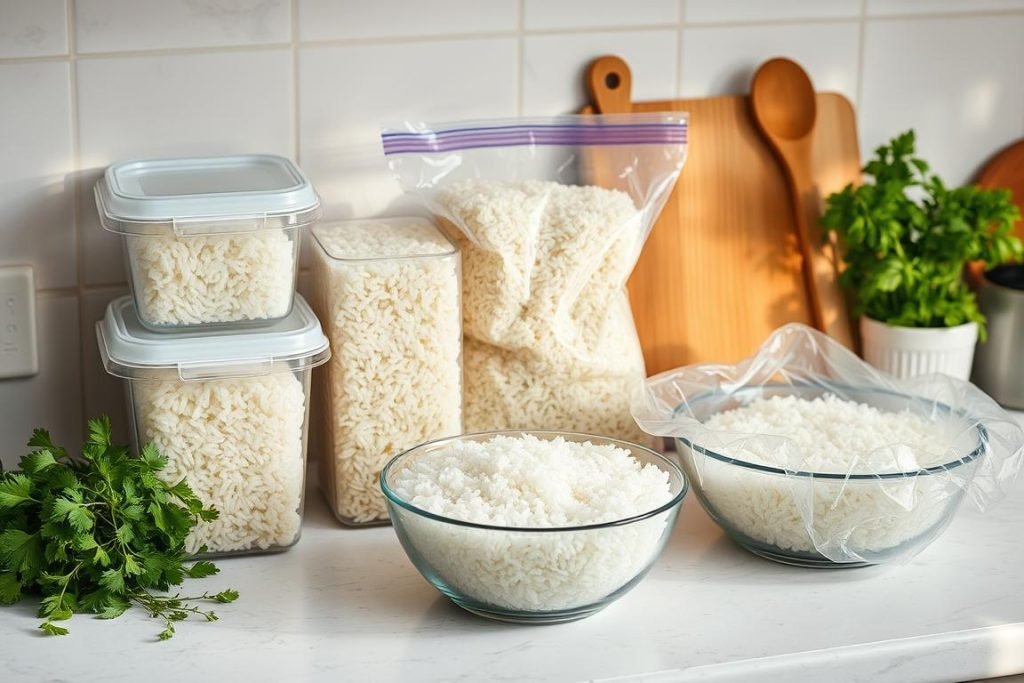Perfect Steamed Rice: A Step-by-Step Guide

Ever wondered how chefs make rice so fluffy it melts in your mouth? It’s not magic. It’s all about the right method. From busy Tokyo restaurants to small kitchens in Tuscaloosa, perfect rice is about precision. Could a simple guide help you make perfect rice in your kitchen? Let’s discover the secret to steaming rice. This will change how you cook this popular grain.
Key Takeaways
- Achieving perfect steamed rice starts with the right water to rice ratio, typically 2:1
- Toast rice with olive oil before cooking to enhance flavor
- Japanese steamed rice brands like Sasanishiki and Koshihikari elevate the dish with their unique qualities
- Soaking rice before cooking ensures fluffy grains and optimal texture
- Using the right equipment, such as a heavy-bottomed saucepan, and cooking precisely for 15 minutes simmering plus 5 minutes resting is key to consistency
- Soft water, or filtered in hard water areas, and thorough rinsing of rice can greatly improve the final product
- The nutritional information per serving offers a balance of energy, protein, and minimal fats
Understanding Steaming Rice
Steaming rice is a special way to cook that’s loved around the world. It makes the rice tender but keeps each grain separate. It’s great in Asian food. It goes well with many dishes, like dumplings and dim sum.
What Is Steaming Rice?
When you steam rice, you cook it with steam, not in water. The steam comes from boiling water below the rice. This makes the rice fluffy and not sticky.
Benefits of Steamed Rice
Steaming rice is very healthy. It doesn’t need oil or fat. This method keeps more vitamins in the rice. It’s great for dishes that are good for you but still tasty.
Different Types of Rice for Steaming
Choosing the right rice is important. Long grains like Jasmine and Basmati are best for steaming. They’re fluffy and smell good, perfect for many kinds of food.
Here’s a look at different rices for steaming:
| Rice Variety | Texture | Common Use |
|---|---|---|
| Jasmine | Light, fluffy | Thai and Southeast Asian dishes |
| Basmati | Fluffy, slightly dry | Indian and Middle Eastern cuisine |
| Sushi Rice | Sticky, moist | Japanese sushi and other Asian dishes |
| Brown Rice | Dense, chewy | Health-conscious meals |
Want to make perfect dumpling sides or just a pot of fluffy rice? Learning these basics will help. Try steaming rice. It makes meals delicious.
Essential Equipment for Steaming Rice
To steam rice well, choosing the right tools is key. It really makes cooking easier and better. Steaming rice is important for yummy Asian dishes like gyoza, wonton, and baozi. You need the right heat and moistness. Various tools can help with this.
Steamer Options: Bamboo vs. Electric
Picking a bamboo or electric steamer depends on what you like and how you cook. Bamboo steamers are great because they soak up extra water. This makes your steamed dishes just right. Electric steamers, on the other hand, are easy to use and keep things consistent. They’re great for those who like doing many things at once in the kitchen.
Choosing the Right Pot
The best pot for steaming rice has a lid that fits well. This helps keep the steam just right. This is how you get rice that’s fluffy and not stuck together. It’s perfect with dishes like baozi or wonton.
Using a Microwave for Steaming
A microwave can also steam rice quickly. Just use a microwave-safe dish with a lid. Add water and rice, then heat until it boils. It’s a fast way to make steamed rice. This comes in handy when you’re in a hurry or want steamed rice with quick meals.
Check out this comparison of steaming equipment and their prices. It will help you find what you need:
| Equipment | Description | Price |
|---|---|---|
| Tatung Electric Steamer | An all-in-one electric steamer that provides consistent heat and timing for steaming rice. | $180 |
| Heavy Duty Dome Lid | Perfect for pots lacking a suitable lid, ensures steam does not escape. | $20 |
| Round Cooling Racks (Set of 3) | Useful for stacking different items to be steamed simultaneously in a bamboo steamer. | $14 |
| Stainless Steel Gripper and Clamp | Aids in safely removing hot dishes or steamer sections after cooking is complete. | $19 |

Preparing Your Rice
Get your rice ready correctly to make it perfect. You need to rinse, soak, and measure rice and water right. Whether it’s for fluffy rice with shumai and xiaolongbao or just good rice, these steps matter a lot.
Rinsing Rice: Why It Matters
Rinsing rice gets rid of extra starch that makes it sticky. For separate, fluffy grains in dishes like xiaolongbao, this is key. Wash it gently in cold water until clear. If you rinse, use a bit less water when cooking.
Soaking Rice for Optimal Texture
Soaking rice improves its texture. It lets grains soak up water before heating for even cooking. Soak it for 30 minutes to make the rice soft and ready for flavors and steam.
Measuring Rice and Water Ratios
Getting the rice to water ratio right is crucial. For cooking on the stove, use 1.5 cups of water for 1 cup of rice. For the microwave, use 2 cups of water per cup of rice. Measure both with one cup for the best rice.

Follow these steps—rinse, soak, and measure right—for perfect rice. These tips help make rice that enhances dishes like shumai and xiaolongbao. They make your meals better.
Step-by-Step Guide to Steaming Rice
Getting your rice just right involves careful steps and knowing the right moves. Whether making tasty momo or yummy manti, the rice quality is key. Follow this guide for perfect, fluffy rice every time.
Step 1: Setting Up Your Steamer
First, pick a pot that’s the right size. This stops the rice from burning and cooks it evenly. Use a 1:1.5 rice to water ratio, important for cooking on a stove. Make sure the steamer basket doesn’t touch the water. If you have an electric steamer, check the water level guide from the maker.
Step 2: Adding the Rice
Wash your rice 2 to 3 times until the water is clear. This drops extra starch and changes the texture. Drain well. Then, spread the rice in the steamer. For momo or manti rice, spread the grains well so each one cooks right.
Step 3: Cooking Time and Temperature
On the stove, let the water boil then simmer. Cover and cook for 13 minutes. Then turn the heat off and let it sit for 10 minutes. This makes the rice nicer. Keep the lid on tight to keep the steam in. Time and temperature control are very important here.
| Cooking Method | Time | Water to Rice Ratio | Notes |
|---|---|---|---|
| Stove | 13 minutes | 1.5 cups of water to 1 cup of rice | Best for traditional recipes. Adjust water if rice is rinsed. |
| Oven | 35 minutes | 1.5 cups of water to 1 cup of rice | Good for large batches; keep covered throughout. |
| Microwave | 12 minutes | 2 cups of water to 1 cup of rice | Quick and convenient; adjust water for different rice types. |

With these easy steps, your rice will be great every time. It makes the perfect start for many meals. Remember, good rice isn’t just about ratio and cooking time. Letting it sit after cooking is also a must for the right texture.
Tips for Perfectly Steamed Rice
Learning how to steam rice well can open up lots of cooking chances. To get your rice light and tasty, you need to know a few important things. Here’s what you can do to make your steamed rice great every time.
Avoiding Sticky Rice
For light, non-sticky rice, picking the right kind of rice and water amount is key. Use a water to rice ratio of 1¾:1 for white rice that’s long or medium grain. Make sure you rinse your rice until the water looks clear. This gets rid of extra starch that makes rice sticky.
Achieving Fluffy Texture
To get fluffy rice, keep the pot lid on to hold in steam and pressure. Choose a big pot to avoid rice bumping into each other and cooking unevenly. After cooking, let the rice sit with the lid on for 5-10 minutes off the stove. This helps the rice grains get light and fluffy.
Enhancing Flavor with Seasoning
Adding flavors to rice makes it so much better. Even something simple like a bit of salt or some olive oil can make a big difference. Want richer tastes? Try cooking rice in chicken broth. Or mix in herbs like thyme, rosemary, and a bay leaf. These little steps can make your steamed rice smell and taste amazing.
| Method | Water to Rice Ratio | Cooking Time | Tips |
|---|---|---|---|
| Stovetop (White Rice) | 1:1.75 | 18 min simmer + 5 min rest | Rinse rice; do not uncover |
| Microwave (Brown Basmati) | 1:2 | 15-25 min | Use microwave-safe dish |
| Oven | 1:2 | 25-60 min | Cover the dish with foil |
| Electric Cooker | Varies | Depends on setting | Follow manufacturer’s instructions |

Common Mistakes to Avoid
Cooking rice right is more than just a recipe. You have to avoid some mistakes too. These mistakes can mess up your rice’s texture and taste. Knowing what they are helps you make perfect rice every time.
Overcooking Rice
Overcooking is a big mistake. It makes rice mushy. Watch the time and don’t peek by lifting the lid. Every time you do, steam gets out and changes how the rice cooks. Cooking rice should be done without fiddling to cook it evenly.
Skipping the Rinsing Process
Some people don’t rinse rice, leading to sticky or gummy rice. You should always rinse rice until the water is clear. For long-grain rice like Jasmine or Basmati, this keeps the grains from sticking and makes them just right.
Using Incorrect Water Ratios
Not using the right water-to-rice ratio is a common mistake. This ratio is key for perfect rice. For example, white rice usually needs 1 ¾ cups of water for each cup of rice, but brown rice needs more. If you’ve rinsed the rice, adjust the water a little because rinsed rice holds some water.
| Rice Type | Recommended Water-to-Rice Ratio | Adjustment if Rinsed |
|---|---|---|
| White Rice | 1 ¾ cups water per 1 cup rice | Reduce water by 2 tablespoons |
| Brown Rice | 2 ¼ cups water per 1 cup rice | Reduce water by 2 tablespoons |
| Basmati Rice | 1 ½ cups water per 1 cup rice | Reduce water by 2 tablespoons |
| Jasmine Rice | 1 ½ cups water per 1 cup rice | Reduce water by 1-2 tablespoons |

Storing Leftover Steamed Rice
Storing and reheating leftover rice the right way keeps it yummy and safe to eat. Doing it right stops bad bacteria from growing. Here are the best ways to store rice and warm it up again.
Best Practices for Refrigeration
Cool your rice quickly and put it in the fridge within two hours of cooking. Spread it on a lined baking sheet to cool it fast. Then, put it in an airtight container in the fridge.
This keeps the rice tasty and safe for three to four days.
Reheating Tips for Leftovers
Adding a little water (1 Tbsp per cup of rice) when reheating helps bring back moisture. If you like more flavor, add some butter or oil. Make sure the rice gets hot enough (165 degrees Fahrenheit for 15 seconds) to kill any germs.
Leftover rice can also go directly into hot dishes like soups or stir-fries. It’s an easy way to make your meals better.

| Storage Method | Duration | Additional Tips |
|---|---|---|
| Refrigerator | 3-4 days | Store in airtight containers, cool rapidly before refrigerating. |
| Freezer | Up to 6 months | Use freezer-safe containers or bags. Thaw by reheating with added moisture. |
| Direct Cooking Add-In | Use immediately from frozen/refrigerated state | Great for stir-fries, soups, and stews. |
These tips will keep your rice fresh and safe. Whether keeping rice cold or heating it up, you’ll get the most flavor.
Serving Suggestions for Steamed Rice
Steamed rice is a key dish in many kitchens around the world. It’s the main part of lots of yummy and healthy meals. Whether you want cozy rice combos, meaty sides, or fun new rice ideas, we’ve got you covered here.
Pairing Steamed Rice with Proteins
Protein makes any meal more filling and nutritious. Steamed rice goes great with different proteins. You can easily make a balanced meal with rice and proteins like chicken, beef, or fish. For a quick bite, try Ready to Serve rice that heats up in 60-90 seconds. It’s perfect for when you’re busy but still want something good to eat.
Incorporating Vegetables
Adding veggies to your rice dishes boosts nutrition and taste. Mix in vegetables like carrots and broccoli when cooking. Or, add fresh herbs or nopalitos for quick flavor. Make your rice special for holidays with dishes like Fiesta Rice or Mint and Feta Rice Salad. These make your plain rice exciting.
Creative Rice Dishes to Try
Feeling creative? You can turn steamed rice into amazing dishes. Try making Spiced Curry Coconut Rice or stir tres quesos cheese sauce into your rice. Or, make a tasty rice pilaf with chicken broth and herbs. These easy recipes can turn simple rice into something special your family will adore.

Steamed rice dishes can be simple or fancy, however you like. Add proteins, veggies, or try new recipes to make your rice exciting. Enjoy cooking and explore all the fun ways to make steamed rice a standout dish. Happy cooking!
Conclusion: Mastering the Art of Steaming Rice
Learning to steam rice perfectly isn’t just about following steps. It’s about knowing the small details that make rice great. It’s possible to cook rice perfectly by paying attention. This includes choosing the right tools and knowing the right amount of water to use. Whether it’s Basmati or Jasmine rice, being precise and careful will lead to great tasting rice.
Recap of Key Points
Steaming rice right involves several important steps. First, wash your rice well. Then use the right amount of water. For white rice, a 1:2 water-to-rice ratio is standard. Letting the rice sit for 5 to 10 minutes after cooking is key. This makes the rice fluffy and not sticky. Whether you use a rice cooker or the stovetop, remember the right water ratios and cooking times. For Basmati on the stove, it’s a 1.5:1 ratio and cook for 20 minutes.
Encouragement for Experimentation
Your rice steaming journey will have you trying new things. As you get better, you might change water amounts or how long you cook the rice. This depends on the rice type or the recipe you’re making. Don’t be afraid to try new kinds of rice. With each try, you’ll get better at seeing what makes rice cook perfectly. Here’s to the delicious meals you’ll make on your cooking adventure.